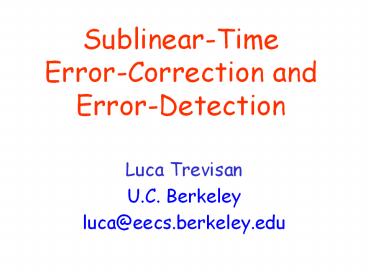Sublinear-Time Error-Correction and Error-Detection - PowerPoint PPT Presentation
Title:
Sublinear-Time Error-Correction and Error-Detection
Description:
Sublinear-Time Error-Correction and Error-Detection Luca Trevisan U.C. Berkeley luca_at_eecs.berkeley.edu – PowerPoint PPT presentation
Number of Views:102
Avg rating:3.0/5.0
Title: Sublinear-Time Error-Correction and Error-Detection
1
Sublinear-Time Error-Correction and
Error-Detection
- Luca Trevisan
- U.C. Berkeley
- luca_at_eecs.berkeley.edu
2
Contents
- Survey of results on error-correcting codes with
sub-linear time checking and decoding procedures - Most of the results not proved by the speaker
- Some of the results not yet proved by anybody
3
Error-correction
4
Error-detection
5
Minimum Distance
6
Ideally
- Constant information rate
- Linear minimum distance
- Very efficient decoding
Sipser-Spielman linear time deterministic
procedure
7
Sub-linear time decoding?
- Must be probabilistic
- Must have some probability of incorrect decoding
- Even so, is it possible?
8
Reasons to be interested
- Sub-linear time decoding useful for worst-case to
average-case reductions, and in
information-theoretic Private Information
Retrieval - Sub-linear time checking arises in PCP
- Useful in practice?
9
Hadamard Code
10
Constant time decoding
11
Analysis
12
A Lower Bound
- If the code is linear, the alphabet is small,
and the decoding procedure uses two queries - Then exponential encoding length is necessary
- Goldreich-Trevisan, Samorodnitsky
13
More trade-offs
- For k queries and binary alphabet
- More complicated formulas for bigger alphabet
14
Construction without polynomials
15
Negative result 1
- Suppose C0,1n -gt 0,1m
- is code with decoding procedure that reads
only k bits of corrupted encoding - Pick random x, compute C(x), project C(x) on
m(k-1)/k coordinates, prove that it still
contains W(n) bits of info. about x. - Then it must be mW(nk/(k-1))
- Katz-Trevisan
16
Negative Result 2
- Suppose C0,1n -gt 0,1m
- is linear code with decoding procedure that
reads only 2 bits of corrupted encoding - Then there are vectors a1am in 0,1n such that
for each i1,,n there are W(m) disjoint pairs
j1,j2 such that - aj1 xor aj2 ei
- Then it must be mexp(W(n))
- Goldreich-Trevisan, Samorodnitksy
17
Checking polynomial codes
- Consider encoding with multivariate low-degree
polynomials - Given p, pick random z, do the decoding for p(z),
compare with actual value of p(z) - Simple case of low-degree test. Rejection prob.
proportional to distance from code.
Rubinfeld-Sudan
18
Bivariate Low Degree Test
- A degree-d bivariate polynomial
- pF x F -gt F is represented as 2F elements of
Fd (the univariate polynomial qa (y) p(a,y)
for each a and the polynomial rb(x) p(x,b) for
each b - Test pick random a and b, read qa and rb, check
that qa(b)rb(a)
19
Analysis
- If F is a constant factor bigger than d, then
rejection probability is proportional to distance
from code - Arora-Safra, ALMSS,
- Polishuck-Spielman
20
Efficiency of Decoding vs Checking
21
Tensor Product Codes
- Suppose we have a linear code C with codewords in
0,1m. - Define new code C with codewords in 0,1(mxm)
- a matrix is a codeword of C if each row and
each column is codeword for C - If C has lots of codeword and large minimum
distance, same true for C
22
Generalization of the Bivariate Low Degree Test
- Suppose C has K codewords
- Define code C over alphabet K, with codewords
of length 2m - C has as many codewords as C
- For each codeword y of C, corresponding codeword
in C contains value of each row and each column
of y - Test pick a random row and a random column,
check intersection agrees - Analysis?
23
Negative Results?
- No known lower bound for locally checkable codes
- Possible to get encoding length n(1o(1)) and
checking with O(1) queries and 0,1 alphabet? - Possible to get encoding length O(n) with O(1)
queries and small alphabet?
24
Applications?
- Better locally decodable codes have applications
to PIR - General/simple analysis of checkable proofs could
have application to PCP (linear-length PCP,
simple proof of the PCP theorem) - Applications to the practice of fault-tolerant
data storage/transmission?































